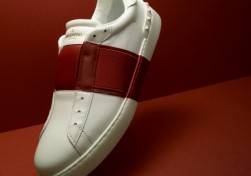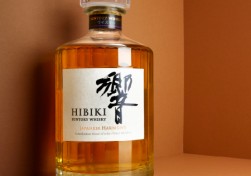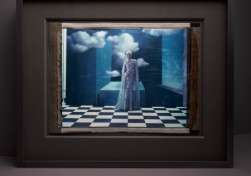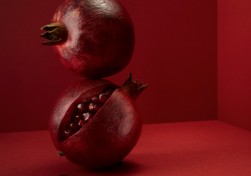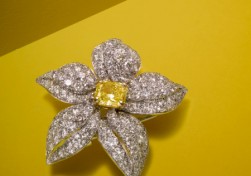So common is sportswear as daily wear, it has a special word: “athleisure”. And it’s booming. The greatest athleisure talisman is the training shoe, which has always had a bit of cachet since it emerged as a streetwear fashion item in the 1970s. These days sneakers are also viewed as exclusive after-party wear – with prices to match. Valentino’s elastic band sneaker, pictured, is at the reasonable end of the market, at about $600. You can drop $3K on Fendi’s Monster Python Leather High-Tops. Stefano Ricci’s suede and croc trim sneakers run to $6,470, while Rick Owens’ Faun Geobasket shoes, made from alligator leather, are about $8,500. Meanwhile, there’s a battle to be the most expensive sneaker, a record currently held by The Fire Monkey, designed by Bicion and Mache Custom Kicks. Priced at $4m, they’re a glittering symphony of diamonds and sapphires with a solid-gold tag. But what type of occasion are top-end sneakers for? They could be for state visits – Cara Delevingne wore Pumas to the White House – or they could equally be for the office or coffee bar. Whatever the event, a pair of thousand-buck sneakers is more likely to be “leisure” than “ath”. valentino.com
It’s curious that new technology is making us hark back to old technology with nostalgia-infused fondness. Take lightbulbs. The market for LEDs is booming, and yet there has been a massive march of old-fashioned glass globes with exposed and often decorative filaments. The New York restaurant Craft is said to have kickstarted the trend more than a decade ago, with many of the world’s hippest cafés, eateries and homes following suit. So why the return? They’re often far warmer, twinklier and more expressive than hi-tech LEDs. Crucially, filament lights work well with the industrial-loft look. Find an exposed brick and a filament will not be far behind. But there’s one problem: traditional incandescent lightbulbs are being phased out in many parts of the world, due to their energy-inefficiency. So, what to do? Make environmentally friendly lights that look like filament lights. In the US, the firm Newcandescent started doing this in 2010 and the CEO, Larry Birnbaum, now offers a range of lights with all the stars, hearts and spirals you need. “We’re all addicted to that soft, warm glow,” says Birnbaum. newcandescent.com
Once, all whisky connoisseurs deferred to Scotland, and although whisky was made elsewhere, it was considered a pale imitation. But over the last decade there has been a real growth in Asian whiskies, notably in Japan. A keen whisky-drinking nation, it has made the drink for almost a century. “In the 2000s, Japanese whiskies started winning awards and couldn’t be ignored any longer,” says Dominic Roskrow, author of Whisky Japan: The Essential Guide to the World’s Most Exotic Whisky. “Now Japan is one of the holy grails of whisky drinkers, with specialist bars and a real buzz with connoisseurs.” Although based on Scotch, one can find many styles, from plummy to peaty, floral to fragrant. People are discovering the differences and specifying Hakushu 12 Year Old or Yamazaki Bourbon Barrel. “The fact that Japanese whiskies are often made in small batches, and are often pricey, adds to their glamour,” says Roskrow. “It also means collectors are snapping them up, like the recent release of a Yamazaki single malt, matured in Scotland in Bowmore casks. It was my whisky of 2016.” yamazaki.com
In October, Bonham’s put up an auction of Polaroid photographs by the director Andrei Tarkovsky. These square, framed images were intended by the Russian film director to be ephemeral – guidance for the shots needed for his 1983 film Nostalgia. Yet interest in them was huge. Indeed, despite the fact that Polaroids were designed to be disposable, they have become increasingly collectible. When this ground-breaking self-developing film was first released in 1947, it seemed magical. Few could resist the allure of watching an image form before their eyes. The Polaroid company filed for bankruptcy in 2008, but the format still has plenty of devotees, like Silicon Valley entrepreneurs Tommy Stadlen and Frederick Blackford, who have started an iPhone app called Polaroid Swing. “In its heyday, Polaroid was Andy Warhol, buzzing around Manhattan taking pictures,” says Blackford. “We felt if we could connect the design heritage and the brand with cutting-edge technology, and make Polaroid a forward-thinking innovation brand again, we could do something really special.” polaroid.com
The pomegranate is having a moment. This is partly due to its “superfood” status: rammed with antioxidants, it’s a nutrient bomb – as suggested by its French name, “grenade”. It’s also visually arresting, inspiring painters like Henri Matisse, whose Still Life with Pomegranates (1947) can be seen at the Matisse Museum in Nice. Most importantly, it’s the centerpiece of a worldwide rediscovery of Levantine cooking. Ozlem Warren of Ozlem’s Turkish Table, which teaches Turkish cooking in Jordan, the US and the UK, is loving the fruit’s new-found attention. “It’s wonderful, the food of the Sultans,” she says. “Pomegranate molasses is the new balsamic vinegar.” Now this sweet-sour flavor is conquering Western tables, and there’s a growing awareness of pomegranate varietals: from the most popular, simply called Wonderful, to the Russian variety Salavatski. Whichever you choose, they all have that sense of fecund mystery when jewel-like arils spill from their chrysalis-like skin. “We Turks have a saying,” says Ozlem. “ ‘I bought one pomegranate home from market. Now I have a thousand.’ ” ozlemsturkishtable.com
When Prince George, the youngest member of the British royal family, was born in 2013, he received a fantastic range of luxurious gifts. But one in particular captured the public attention: a rocking horse from toy manufacturers Stevenson Brothers. Somehow, the rocking horse ticks all the right boxes: it’s an heirloom, a domestic icon, and it carries a sense of childhood past as well as a feeling of continuity. But had the rocking horse become stuck in a 19th-century groove? Well, yes, which is why modish parents everywhere will be delighted that, in recent years, rocking horses have been given a new lease on life. Designer Marc Newson set the ball rolling with Rocky, made in 2012 for the design company Magis. Then came Reggie the Eco Rocker, by Australian designer Shell Thomas, a flat-pack cardboard rocking horse made of tough Ultraboard. But our favorite is Kartell Kids’ H-Horse (pictured) by Canadian/Japanese designer Nendo, rendered in transparent methacrylate. This model has taken the rocking horse to a whole new level of design-buff seriousness. Stylish, innovative, fun… it rocks. kartell.com
Once considered fusty and outmoded, there are signs that the brooch is fashionable again. Last summer, for example, Uma Thurman wore a vintage Cartier Birds of Paradise brooch to the Met Gala. Look into the brooch’s history and you’ll find a fascinating world of ceremonial genres: the “aigrette” feather-shaped brooch, the “grand tour” cameo brooch, and the “en tremblant” – the figure that trembles like the flutter of a romantic heart. The diamond company Graff’s brooch of yellow and white diamonds, pictured here, exquisitely reinterprets the en tremblant for our era. The brooch is also a real power jewel. Think of former Secretary of State Madeleine Albright and her 2009 hymn to the brooch, Read My Pins, about her huge collection of brooches and how they expressed her politics. “I saw it as a visual way to deliver a message,” she said. For example, when her team learned that the Russians had planted a listening device in a conference room, she wore a brooch in the shape of a bug to their next meeting. “They got the message.” Now that’s statement jewelry. graffdiamonds.com
